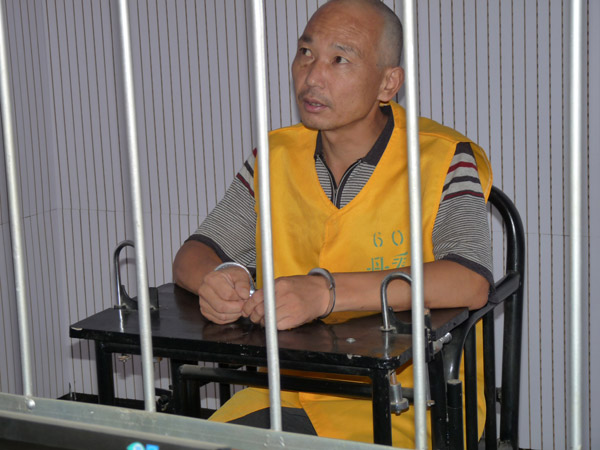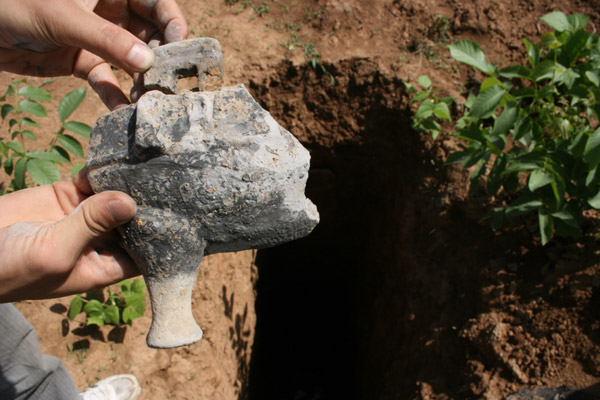Tomb raiders remain a menace
Updated: 2011-09-07 07:28
By Zhang Yan (China Daily)
|
|||||||||
Professional criminals target vulnerable cultural treasures, Zhang Yan reports from Xi'an.
 |
|
Pan Liusuo, a 48-year-old suspected gang leader from Henan, is detained at the Danfeng county detention house on suspicion of tomb raiding.[Photo/China Daily] |
Despite increasing efforts to tackle the illegal traffic in cultural artifacts, every year thieves break into tombs and steal priceless treasures.
These thefts endanger China's cultural heritage as never before, said Wei Yongshun, a senior officer from the Ministry of Public Security's criminal investigation bureau.
"Sheer greed and a fanaticism are behind these crimes," Wei said.
Police investigated 973 cases in 2010 involving cultural artifacts. Of these, 451 related to tomb raids and 387 to theft. From January to June 2010, authorities smashed 71 gangs, detained 787 suspects and recovered 2,366 artifacts, according to ministry figures.
Wei said most tomb raids are committed by gangs, which are much more organized than individuals, and have the means to easily dispose of their loot.
He said the members of these sorts of gangs often have specialties.
"Usually a gang leader stays behind to fund the whole operation, and a special technical advisor finds and blows up a tomb site," he said. "They often also hire groups of professional grave robbers to carry out a crime."
Advanced technology is also used. Tomb raiders have been known to employ explosives, walkie-talkies, night-vision goggles, various lights, oxygen canisters, antiviral masks, motorcycles, cars and various devices used to find the locations of tombs, the ministry official said.
After a tomb has been looted, a gang boss will usually pay the grave robbers he has hired and then try to sell the artifacts immediately or to smuggle them overseas.
"The gangsters almost always use fake names and kept the artifacts they had stolen in their hands for a short time," Wei said. "That has added to the practical difficulty of finding and getting these stolen items back."
Making matters worse, Wei said, is the fact that local governments are at times indifferent to these types of crimes or are too weak to prevent them.
Wei said tomb raiders often use online technology, such as instant messaging and e-mails, to trade with buyers of rare cultural artifacts.
"The Internet is a place where the judging and ordering of samples, discussions about prices and payment transaction can all occur," Wei said.
In recent years, the traffic in cultural artifacts has accelerated and has begun to take place in ever more clandestine ways, he said.
"These sorts of criminals have shown ingenuity by illegally buying or trafficking cultural artifacts under the guise of managing antique shops or selling used goods," Wei said. "Flea markets have also become places where artifacts either are sold or taken to be smuggled out of the country."
Chinese gang leaders have also been known to work with overseas traffickers, and sometimes customs officials fail in their duty to prevent such items from leaving the country, he said.
"Stolen cultural artifacts are usually first smuggled out through Hong Kong and Macao and then taken to Taiwan, Canada, America or European countries to be traded," he said.
Diminishing resource
 |
|
Several holes left behind by tomb raiders are exposed in cornfields in Chengguan town of Luonan county, Shaanxi province, on July 8. Pottery fragments and broken pieces of a wooden coffin were found near the holes' entrances. [Photo/China Daily] |
"If we don't take immediate and effective steps to protect these artifacts, there will be none of these things left to protect in 10 years," Luo Xizhe , director of the Shaanxi Provincial Cultural Relics Bureau's heritage inspection and safety department.
Some of the most notorious cases of tomb raiding have occurred in Shaanxi province's Xi'an, a city once known as Chang'an, which was the capital of the Zhou, Qin, Han, Tang dynasties and nine other Chinese imperial dynasties. Civilization has existed in Shaanxi since the 11th century BC, causing it to contain some of the oldest cultural artifacts in the world.
The State has granted the highest level of official protection to be had in China to 139 heritage sites in Shaanxi. Most famous among them is the tomb of Qin Shi Huang, the first emperor of China, who was buried with an army of terracotta warriors. Elsewhere, among the 900,000 cultural artifacts kept at 70 museums in the province, are 3,256 pieces that are considered to be of the highest quality.
"The rich heritage of Shaanxi has made the province the main target of grave robbers, largely because of its large numbers of high-quality, rare and valuable artifacts," Luo said.
Since 2009, the Shaanxi police cracked more than 250 tomb-raiding cases, detaining 500 suspects, according to statistics from the Shaanxi public security department. They have also recovered 1,500 cultural artifacts, including 10 that are considered to be of the highest quality.
"Nearly all the ancient tombs that are clearly marked bear evidence that they have been raided repeatedly," he said, adding that in some places where ancient tombs are subject to special protection, dozens of holes have been found indicating people had been trying to probe the contents of the earth.
In Shaanxi, most of the members of tomb-raiding gangs hail from Henan, Shanxi, Gansu and Shaanxi provinces. They are often villagers who are from 30 to 50 years old and who have acquired special techniques that come in useful in stealing cultural artifacts, Wu Zhongfei, deputy director of Shaanxi Provincial Public Security Bureau's criminal investigation department, told China Daily in an exclusive interview.
"They are often directed by a gang leader who stays behind and works with villagers to commit the crime," Wu said."Farmers are much more familiar with the local terrain. They usually help a gang to find a tomb site, and give them a place to take shelter in and hide from the police."
Two insiders in the artifact trade in Shaanxi who declined to state their full names said, "There are almost 100,000 professional tomb raiders here who can provide supplies to us. "
"An average of four to five professional gangs that raid tombs exist in each of the worst-hit counties in Shaanxi, and some gangs even have established some kind of relationship with the local government and manage to establish deep roots," said a police officer who is responsible for investigating artifacts crimes in Shaanxi and who declined to provide his full name.
Preventative measures
Wu said the Shaanxi police and the provincial cultural heritage bureau are fighting these crimes by establishing a law enforcement agency charged specifically with protecting artifacts.
They also plan to ask villagers to join a full-time patrol team that will keep a vigil in protected areas near historical graves, especially at night.
In the next five years, the State Administration of Cultural Heritage and Shaanxi Provincial Cultural Department plan to spend more than 100 million yuan ($15.6 million) on equipment to monitor ancient tombs.
Most graves now have no monitoring system protecting them, Luo said.
"We have so little money," he said. "And to monitor just one small grave we need at least 5 million yuan to install monitoring equipment, including video surveillance equipment that can be used in the daytime and infrared thermal imaging devices to be used at night."
Recent raids
Past cases of tomb raiding show how difficult it can be to guard historical graves but also give reason to hope that stolen cultural artifacts can be recovered.
In August, four men were detained by police for excavating ancient tombs in Danfeng county in Shangluo, a city in Shaanxi province.
The suspects, who ranged in age from 30 to 50, came from Henan and Shaanxi, lending weight to authorities' belief that criminals from the bordering provinces are working together.
The four members of the alleged gang, headed by Pan Liusuo, 48, who hails from Henan, hired three villagers from the same province to help them in the theft. They also gained the complicity of a villager in Danfeng county, who agreed to unearth the historical tombs and share whatever booty was discovered.
On Aug 16, when they began to dig a hole at one gravesite, they were come upon by a team formed to patrol the graves. Believing them to be members of a criminal gang, the team immediately called the police, who rushed to the site and detained the suspects.
Pan Baocheng, a 53-year-old gang member from Henan, told China Daily he became a criminal simply out of greed.
"I just thought it would be a quick way to become rich," he said. "When I was detained by the police and lost my freedom, I began to reflect and then realized that I had committed a serious crime."
"I sincerely implore other criminals who are eager to raid tombs to think that when they break the law, no matter how much money they get, they will be severely punished sooner or later."
In March, the Ministry of Public Security and the Xi'an police succeeded in persuading two relics collectors in the United States to return a 27-ton coffin and five first-class murals, which were taken in 2006 from the tomb of Wu Huifei (699-737), a concubine of Tang Xuanzong (685- 762), the seventh emperor of the Tang Dynasty .
The pieces had been stolen in February 2006, when a criminal gang raided a Tang Dynasty imperial tomb in a southern suburb of Xi'an.
Following an investigation, the Xi'an police caught Yang Bin, who was later found guilty of leading a criminal gang that raided tombs.
After four years of searching for the stolen treasures, authorities found them in the possession of two collectors in the United States, who were eventually persuaded to return them to the Shaanxi History Museum.
Do the crime
Those who are caught stealing artifacts face stiff penalties. If convicted of breaking into ancient cultural sites or tombs that have historical, artistic or scientific value, criminals will receive from three to 10 years in prison and fines, Li Guifang, vice-director of the All China Lawyers' Association's criminal defense department.
If their misdeeds are considered serious, they will spend from 10 years to the rest of their lives behind bars, he said. An amendment to the country's criminal law, adopted in May, makes those punishments stop short of the death penalty.
But before punishments can be considered, criminals must be caught.
Wu acknowledged the police often find it difficult to collect evidence from cases of artifact theft. And most historical tombs are difficult to guard because they occupy large areas, Wu said.
"The majority of the clues we get come from reports made by local cultural departments or villagers," he said.
"Usually, when we arrive at a crime scene, a tomb has been broken into a long time ago. So it's really difficult for us to catch suspects, find stolen loot and completely eradicate these gangs."










